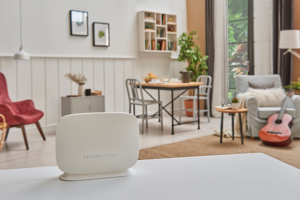Can Wi-Fi be Blocked by Objects?
Everyone knows how annoying it is when your Wi-Fi cuts out, and it’s usually at the worst possible time. Whether you’re streaming a movie, working from home, completing schoolwork, or just scrolling through your phone – having a good Wi-Fi signal is essential to most people’s day-to-day lifestyle.
When I had my router set up by the technician, he placed it behind my TV, and I didn’t think anything of it. But the TV was blocking the Wi-Fi signal from reaching the rest of my home.
Your router wirelessly transmits radio waves to communicate with your devices. Radio waves are part of the electromagnetic spectrum. So, anything that blocks the radio waves’ path to your devices or causes electromagnetic interference – will block or weaken your Wi-Fi signal.
If you are curious about the strength of your Wi-Fi connection overall, or in a specific area of your home – you can always conduct a speed test and check.
What Materials Can Block Wi-Fi?
The worst signal blockers are building materials around your home, but there are many other objects that cause signal issues. I will lay out ten of the most common Wi-Fi blockers, ranked from the most to least problematic.
- Metal: The number one signal blocker. Metal is the hardest material for Wi-Fi signals to penetrate because it can conduct electricity. It absorbs electromagnetic radio waves.
- Televisions: TVs are a double whammy because they are a physical barrier (metals) that weaken signals and they can interfere with the Wi-Fi signals due to the electronics inside the TV.
- Concrete and Plaster Walls: Concrete is one of the thickest building materials and as a result Wi-Fi signals struggle to pass through walls and floors. Most modern homes use metal lathes in plaster to act as framework – which also reduces radio signals.
- Ceramic Tile and Drywall: A material called mastic is used to install ceramic tiles on plaster or drywall. The combination of tile and drywall adds to Wi-Fi interference.
- Mirrors: All mirrors are made with a thin coat of metal on the glass, which causes electromagnetic interference. The bigger the mirror, the larger the effect. Tinted glass windows can also slow down Wi-Fi due to the metallic film on them.
- Other Devices: Most wireless routers use a 2.4 GHz frequency to operate on. Other devices such as cell phones, baby monitors, microwaves, and Bluetooth devices all run under the 2.4 GHZ frequency and thus will interfere with the Wi-Fi radio waves.
- Neighbor’s Wi-Fi: When you go to connect to Wi-Fi on a device you see all the wireless networks close to you, any network that pops up can mess with your connection. This is especially true for apartments.
- Water: As weird as it sounds, any large amounts of water like fish tanks and even the water inside human’s bodies – interfere with Wi-Fi signals. Water is a conductor of electricity, so it can absorb the radio signals from Wi-Fi.
- Appliances: Home appliances such as fridges, ovens, air fryers and dishwashers are all composed of electrical parts and metals, which causes electrical interference.
- Furniture: Lastly, any furniture that blocks the router will diminish the signals. The denser and larger the item, the more interference.
Where to Put a Router for Best Signal
Now that you know all the different objects and materials that can hinder your Wi-Fi signal, the obvious answer is to move your router to an area that has minimal things blocking it from your devices. If your router is not wireless, you can purchase an extension cord to move it to a better area.
It’s always best to place the router up high, because the signals tend to spread out downward from the router. It’s never a good idea to keep your router on the floor and remember to place it somewhat close to your television or computer (but not too close as it will block the signal) in case you want to plug an ethernet cable into it.

Where to Put a Router in a Multi-Story House?
In every house, there will be dead spots around the house that the Wi-Fi signal struggles to reach. For me, in a two-story house, the dead spots are in my basement and upstairs bathroom. For houses with multiple stories, keep the router in an open area on the second floor and away from any other devices for the best possible connection.
To rid your house of dead spots, you can either purchase a whole new mesh router system that comes with “nodes” or extenders that you plug in around your house to extend the signal. Or you can just buy Wi-Fi range extenders to connect to your existing router. You can find these products at electronics stores like Best Buy, or online.
It’s also important to mention that the nodes or extenders can be connected to your video game console, desktop computer, or laptop via ethernet cable to further improve your connection.
Where to Put a Router in an Apartment?
For apartment-dwellers you do not need to worry much about the location, but it should still be placed relatively high-up and in an open area. A side table in the main living area or kitchen is your best bet. Just make sure it’s not too close to your TV or any of the other signal blockers listed above.
Make Room for Your Router with Self Storage
If you need to clear up some clutter that is blocking your Wi-Fi signal, we’re here for you with clean, well-lit self storage units available in a range of sizes to fit all needs and budgets. Check out our Self Storage Calculator, then find the perfect unit near you.


